Revisiting Vrancea (Romania) Intermediate-Depth Seismicity: Some Statistical Characteristics and Seismic Quiescence Testing
Abstract
:1. Introduction
2. Materials and Methods
2.1. Materials
2.2. Methods
3. Results
3.1. Some General Characteristics of Intermediate-Depth Seismicity
3.2. Checking for Seismicity Rate Changes for Vrancea Intermediate-Depth Earthquakes
4. Discussion
5. Conclusions
Supplementary Materials
Author Contributions
Funding
Data Availability Statement
Acknowledgments
Conflicts of Interest
References
- Bala, A.; Raileanu, V.; Dinu, C.; Diaconescu, M. Crustal seismicity and active fault systems in Romania. Rom. Rep. Phys. 2015, 67, 1176–1191. [Google Scholar]
- Roman, C. Seismicity in Romania—Evidence for a sinking lithosphere. Nature 1970, 228, 1176–1178. [Google Scholar] [CrossRef] [PubMed]
- Constantinescu, L.; Enescu, D. The Vrancea Earthquakes in a Scientific and Technological Framework; Romanian Academy: Bucharest, Romania, 1985; pp. 36–46. (In Romanian) [Google Scholar]
- Oncescu, M.C.; Marza, V.I.; Rizescu, M.; Popa, M. The Romanian earthquake catalogue between 984–1997. In Vrancea Earthquakes: Tectonics, Hazard and Risk Mitigation; Wenzel, F., Lungu, D., Eds.; Kluwer Academic Publishers: Dordrecht, The Netherlands, 1999; pp. 43–47. [Google Scholar]
- Jeffreys, I.L. Earthquakes and Mountains; Methuen & Co.: London, UK, 1935. [Google Scholar]
- Trifu, C.-I.; Radulian, M. Asperity distribution and percolation as fundamentals of an earthquake cycle. Phys. Earth Planet. Inter. 1989, 58, 277–288. [Google Scholar] [CrossRef]
- Enescu, D.; Marza, V.; Zamarca, I. Contributions to the statistical prediction of Vrancea earthquakes. Rev. Roum. Geophys. 1974, 18, 67–79. [Google Scholar]
- Purcaru, G. Quasi- and Supercyclicity of Earthquakes and Time-Magnitude Gaps in Earthquake Prediction; NORSAR Scientific Report; NORSAR: Kjeller, Norway, 1974; Volume 6, pp. 53–55. [Google Scholar]
- Lungu, D.; Cornea, T.; Nedelcu, C. Hazard assessment and site-dependent response for Vrancea earthquakes. In Vrancea Earthquakes: Tectonics, Hazard and Risk Mitigation; Wenzel, F., Lungu, D., Eds.; Kluwer Academic Publishers: Dordrecht, The Netherlands, 1999; pp. 251–267. [Google Scholar]
- Ismail-Zadeh, A.; Matenco, L.; Radulian, M.; Cloetingh, S.; Panza, G. Geodynamics and intermediate-depth seismicity in Vrancea (the south-eastern Carpathians): Current state-of-the art. Tectonophysics 2012, 530/531, 50–79. [Google Scholar] [CrossRef]
- Knapp, J.H.; Knapp, C.C.; Raileanu, V.; Matenco, L.; Mocanu, V.; Dinu, C. Crustal constraints on the origin of mantle seismicity in the Vrancea Zone, Romania: The case for active continental lithospheric delamination. Tectonophysics 2005, 410, 311–323. [Google Scholar] [CrossRef]
- Koulakov, I.; Zaharia, B.; Enescu, B.; Radulian, M.; Popa, M.; Parolai, S.; Zschau, J. Delamination or slab detachment beneath Vrancea? New arguments from local earthquake tomography. G-cubed 2010, 11, Q03002. [Google Scholar] [CrossRef]
- Ferrand, T.P.; Manea, E.F. Dehydration-induced earthquakes identified in a subducted oceanic slab beneath Vrancea, Romania. Sci. Rep. 2021, 11, 10315. [Google Scholar] [CrossRef]
- Marza, V.I. A seismicity pattern of March 4, 1977 Vrancea, Romania earthquake: An earthquake prediction insight. Tectonophysics 1979, 57, 317–373. [Google Scholar] [CrossRef]
- Marza, V.I. The Premonitory Content of Seismicity Variations, Manifestations at a Global Scale, with Particularization for the Vrancea Region. Ph.D. Thesis, Bucharest University, București, Romania, 1981. [Google Scholar]
- Marza, V.I.; Burlacu, V.; Pantea, A.; Malita, Z. Case history of an anticipated event: The major (mw = 7.0, Mw = 7.2) Vrancea (Romania) earthquake of 1986–revisited. Rev. Roum. Geophys. 2003, 47, 109–120. [Google Scholar]
- Radulian, M.; Trifu, C.-I. Would it have been possible to predict the 30 August 1986 Vrancea earthquake? Bull. Seismol. Soc. Am. 1991, 81, 2498–2503. [Google Scholar] [CrossRef]
- Bazacliu, O.; Radulian, M. Seismicity variations in depth and time in the Vrancea (Romania) subcrustal region. Nat. Hazards 1999, 19, 165–177. [Google Scholar] [CrossRef]
- Mitrofan, H.; Chitea, F.; Anghelache, M.-A.; Visan, M. Possible triggered seismicity signatures associated with the Vrancea intermediate-depth strong earthquakes (southeast Carpathians, Romania). Seismol. Res. Lett. 2014, 85, 314–323. [Google Scholar] [CrossRef]
- Gutenberg, B.; Richter, C.F. Frequency of Earthquakes in California. Bull. Seismol. Soc. Am. 1944, 34, 185–188. [Google Scholar] [CrossRef]
- Schorlemmer, D.; Wiemer, S.; Wyss, M. Variations in earthquake-size distribution across different stress regimes. Nature 2005, 437, 539–542. [Google Scholar] [CrossRef]
- Herrmann, M.; Piegari, E.; Marzocchi, W. Revealing the spatiotemporal complexity of the magnitude distribution and b-value during an earthquake sequence. Nat. Commun. 2022, 13, 5087. [Google Scholar] [CrossRef]
- Paulescu, D.; Rogozea, M.; Popa, M.; Radulian, M. Digitized database of old seismograms recorder in Romania. Acta Geophys. 2016, 64, 963–977. [Google Scholar] [CrossRef]
- Rau, A.V.; Popa, M.; Ionescu, C.; Paulescu, D. Building up a seismic network in the early days of seismology in Romania. In Insights of Geosciences for Hazards and Education; Chitea, F., Ed.; “Cetatea de Scaun” Publishing House: Targoviste, Romania, 2022; pp. 5–78. [Google Scholar] [CrossRef]
- Popa, M.; Radulian, M.; Ghica, D.; Neagoe, C.; Nastase, E. Romanian Seismic Network since 1980 to the present. In Springer Proceedings in Physics; Springer: Berlin/Heidelberg, Germany, 2013; Volume 163. [Google Scholar] [CrossRef]
- Neagoe, C.; Ionescu, C.; Manea, L. Romanian Complex Data Center for Dense Seismic network. Ann. Geophys. 2011, 54, 9–16. [Google Scholar] [CrossRef]
- Marmureanu, A.; Ionescu, C.; Grecu, B.; Toma-Danila, D.; Tiganescu, A.; Neagoe, C.; Toader, V.; Craifaleanu, I.-G.; Dragomir, C.S.; Meita, V.; et al. From national to transnational seismic monitoring products and services in the Republic of Bulgaria, Republic of Moldova, Romania, and Ukraine. Seismol. Res. Lett. 2021, 92, 1685–1703. [Google Scholar] [CrossRef]
- Popa, M.; Chircea, A.; Dinescu, R.; Neagoe, C.; Grecu, B.; Borleanu, F. Romanian earthquake catalogue (ROMPLUS). Mendeley Data 2022, V2. [Google Scholar] [CrossRef]
- Moldovan, I.A.; Popescu, E.; Constantin, A. Probabilistic seismic hazard assessment in Romania: Application for crustal seismic active zones. Rom. J. Phys. 2008, 53, 575–591. [Google Scholar]
- Oros, E.; Plăcinta, A.O.; Moldovan, I.A. The analysis of earthquakes sequence generated in the Southern Carpathians, Orsova June-July 2020 (Romania): Seismotectonic implications. Rom. Rep. Phys. 2021, 73, 706. [Google Scholar]
- Constantinescu, L.; Mârza, V. A computer-compiled and computed-oriented catalogue of Romanian’s earthquakes during a millennium (984–1979). Rev. Roum. Geol. Geophys. Geograph. Ser. Geophys. 1980, 24, 193–233. [Google Scholar]
- Ardeleanu, L.; Neagoe, C. The performance of the stations of the Romanian Seismic Network in monitoring the local seismic activity. Part I. Vrancea subcrustal seismicity. Rom. Rep. Phys. 2016, 68, 393–415. [Google Scholar]
- D’Allesandro, A.; Danet, A.; Grecu, B. Location performance and detection magnitude threshold of the Romanian National Seismic Network. Pure Appl. Geophys. 2012, 169, 2149–2164. [Google Scholar] [CrossRef]
- Enescu, B.; Moldovan, I.; Radulian, M.; Ghita, C.; Borleanu, F.; Placinta, A.O.; Poiata, N. Seismicity analysis for Vrancea region (Romania) using a z-value statistical approach. In Proceedings of the 3rd European Conference on Earthquake Seismology and Engineering, Bucharest, Romania, 4–9 September 2022. [Google Scholar]
- Husen, S.; Hardebeck, J.L. Earthquake Location Accuracy, Community Online Resource for Statistical Seismicity Analysis. CORSSA 2010. [Google Scholar] [CrossRef]
- Aki, K. Maximum likelihood estimate of b in the formula log N=a-Bm and its confidence limits. Bull. Earthq. Res. Inst. 1965, 43, 237–239. [Google Scholar]
- Utsu, T. A method for determining the value of b in a formula log n=a-bM showing the magnitude-frequency relation for earthquakes. Geophys. Bull. Hokkaido Univ. 1965, 13, 99–103, (In Japanese with English summary). [Google Scholar]
- Shi, Y.; Bolt, B.A. The standard error of the magnitude-frequency b value. Bull. Seismol. Soc. Am. 1982, 72, 1677–1687. [Google Scholar] [CrossRef]
- Woessner, J.; Wiemer, S. Assessing the quality of earthquake catalogues: Estimating the magnitude of completeness and its uncertainty. Bull. Seismol. Soc. Am. 2005, 95, 684–698. [Google Scholar] [CrossRef]
- Wiemer, S.; Wyss, M. Minimum Magnitude of Completeness in Earthquake Catalogs: Examples from Alaska, the Western United States, and Japan. Bull. Seismol. Soc. Am. 2000, 90, 859–869. [Google Scholar] [CrossRef]
- Cao, A.M.; Gao, S.S. Temporal variation of seismic b-values beneath northeastern Japan island arc. Geophys. Res. Lett. 2002, 29, 9. [Google Scholar] [CrossRef]
- Wiemer, S. A Software Package to Analyze Seismicity: ZMAP. Seismol. Res. Lett. 2001, 72, 373–382. [Google Scholar] [CrossRef]
- Matthews, M.V.; Reasenberg, P.A. Statistical methods for investigating quiescence and other temporal seismicity patterns. Pure Appl. Geophys. 1988, 126, 357–372. [Google Scholar] [CrossRef]
- Reasenberg, P.A.; Simpson, R.W. Response of regional seismicity to the static stress change produced by the Loma Prieta earthquake. Science 1992, 255, 1687–1690. [Google Scholar] [CrossRef]
- Wiemer, S.; Wyss, M. Seismic quiescence before the landers (M = 7.5) and big bear (M = 6.5) 1992 earthquakes. Bull. Seismol. Soc. Am. 1994, 84, 900–916. [Google Scholar] [CrossRef]
- Enescu, B.; Struzik, Z.; Kiyono, K. On the recurrence time of earthquakes: Insight from Vrancea (Romania) intermediate-depth events. Geophys. J. Int. 2008, 172, 395–404. [Google Scholar] [CrossRef]
- Telesca, L.; Alcaz, V.; Burtiev, R.; Sandu, I. Time-clustering analysis of the 1978–2008 sub-crustal seismicity of Vrancea region. Nat. Hazards Earth Syst. Sci. 2011, 11, 2335–2340. [Google Scholar] [CrossRef]
- Frohlich, C. Deep Earthquakes; Cambridge University Press: Cambridge, UK, 2006. [Google Scholar] [CrossRef]
- Prieto, G.A.; Beroza, G.C.; Barrett, S.A.; López, G.A.; Florez, M. Earthquake nests as natural laboratories for the study of intermediate-depth earthquake mechanics. Tectonophysics 2005, 570/571, 42–56. [Google Scholar] [CrossRef]
- Trifu, C.-I.; Radulian, M. Frequency-magnitude distribution of earthquakes in Vrancea: Relevance for a discrete model. J. Geophys. Res. 1991, 96, 4301–4311. [Google Scholar] [CrossRef]
- Scholz, C.H. On the stress dependence of the earthquake b value. Geophys. Res. Lett. 2015, 42, 1399–1402. [Google Scholar] [CrossRef]
- Gulia, L.; Wiemer, S. Real-time discrimination of earthquake foreshocks and aftershocks. Nature 2019, 574, 193–199. [Google Scholar] [CrossRef] [PubMed]
- Frohlich, C.; Davis, S. Teleseismic b-values: Or much ado about 1.0. J. Geophys. Res. 1993, 98, 631–644. [Google Scholar] [CrossRef]
- Rogozea, M.; Enescu, B.; Bazacliu, O.; Popa, M.; Radulian, M. Seismicity characteristics in the particular case of Vrancea (Romania) intermediate-depth earthquakes. In Proceedings of the CRC-461 International Symposium on Strong Vrancea Earthquakes and Risk Mitigation, MATRIX ROM, Bucharest, Romania, 4–6 October 2007; pp. 156–160. [Google Scholar]
- Radulian, M.; Popa, M. Scaling of the source parameters for the Vrancea intermediate depth earthquakes. Tectonophysics 1996, 261, 67–81. [Google Scholar] [CrossRef]
- Hurukawa, N.; Imoto, M. Periodic upward migration model for intermediate-depth earthquakes in Vrancea, Romania. Earth Planets Space 2010, 62, 463–473. [Google Scholar] [CrossRef]
- Koch, M. Seismicity and structural investigations of the Romanian Vrancea region: Evidence for azimuthal variations of P-wave velocity and Poisson’s ratio. Tectonophysics 1982, 90, 91–115. [Google Scholar] [CrossRef]
- Kagan, Y.Y. Short-Term Properties of Earthquake Catalogs and Models of Earthquake Source. Bull. Seismol. Soc. Am. 2004, 94, 1207–1228. [Google Scholar] [CrossRef]
- Utsu, T. On seismicity, in Report of the Joint Research Institute for Statistical Mathematics; Institute of Statistical Mathematics: Tokyo, Japan, 1992; pp. 139–157. [Google Scholar]

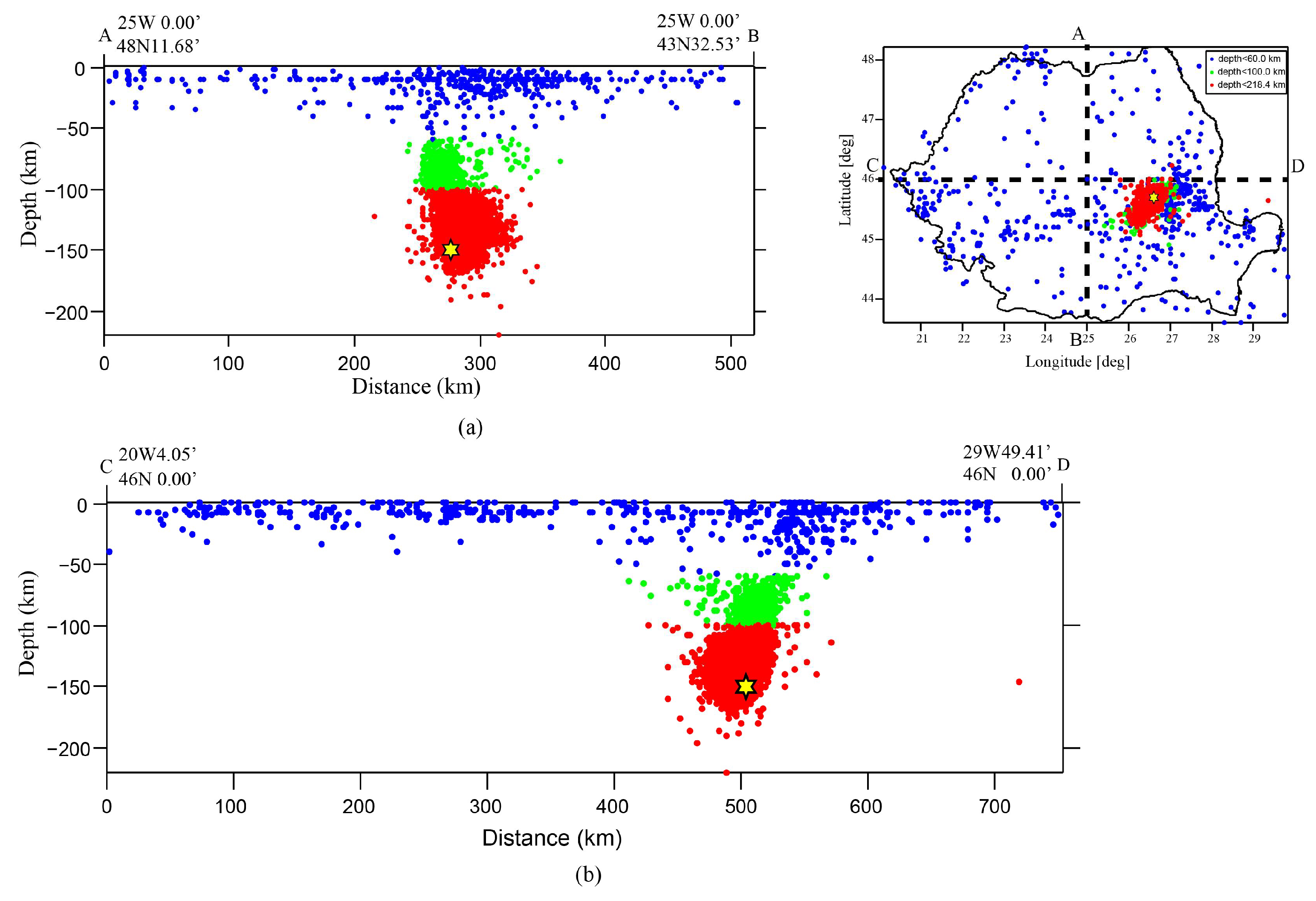
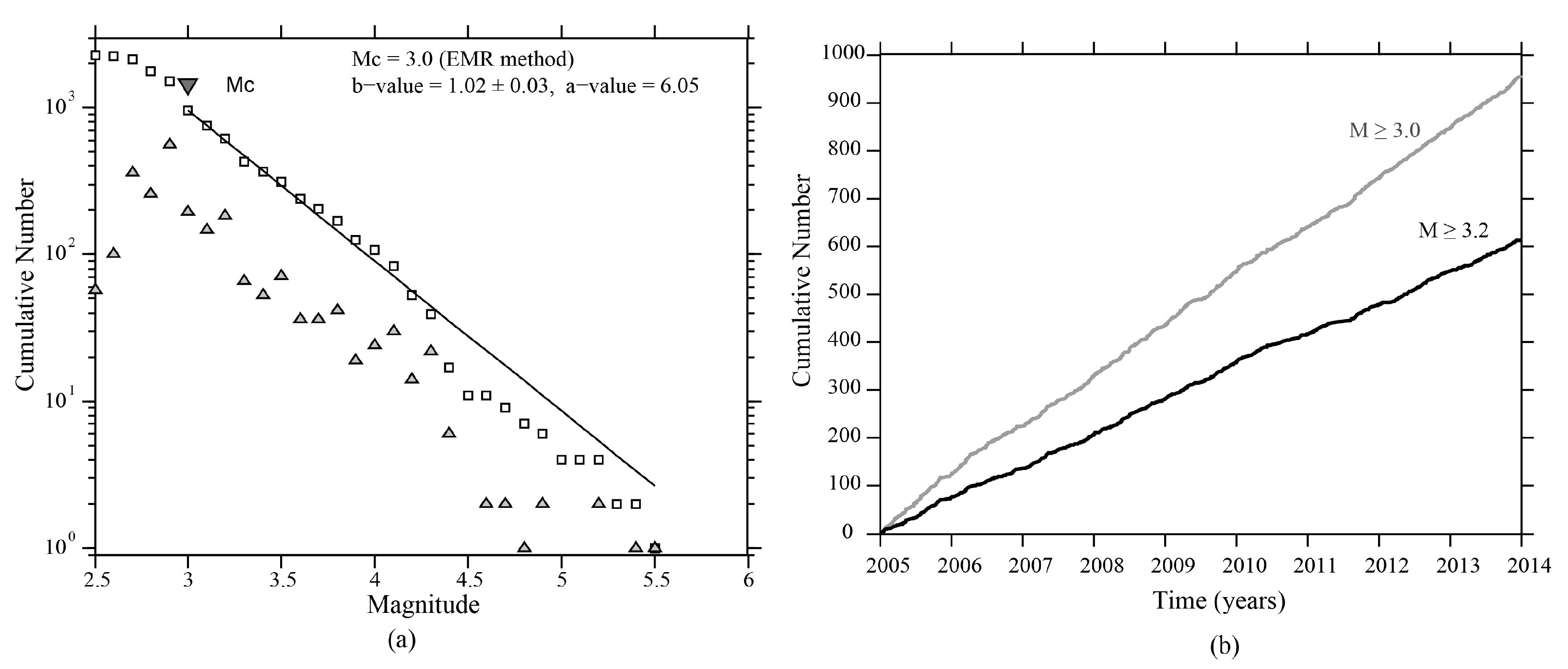

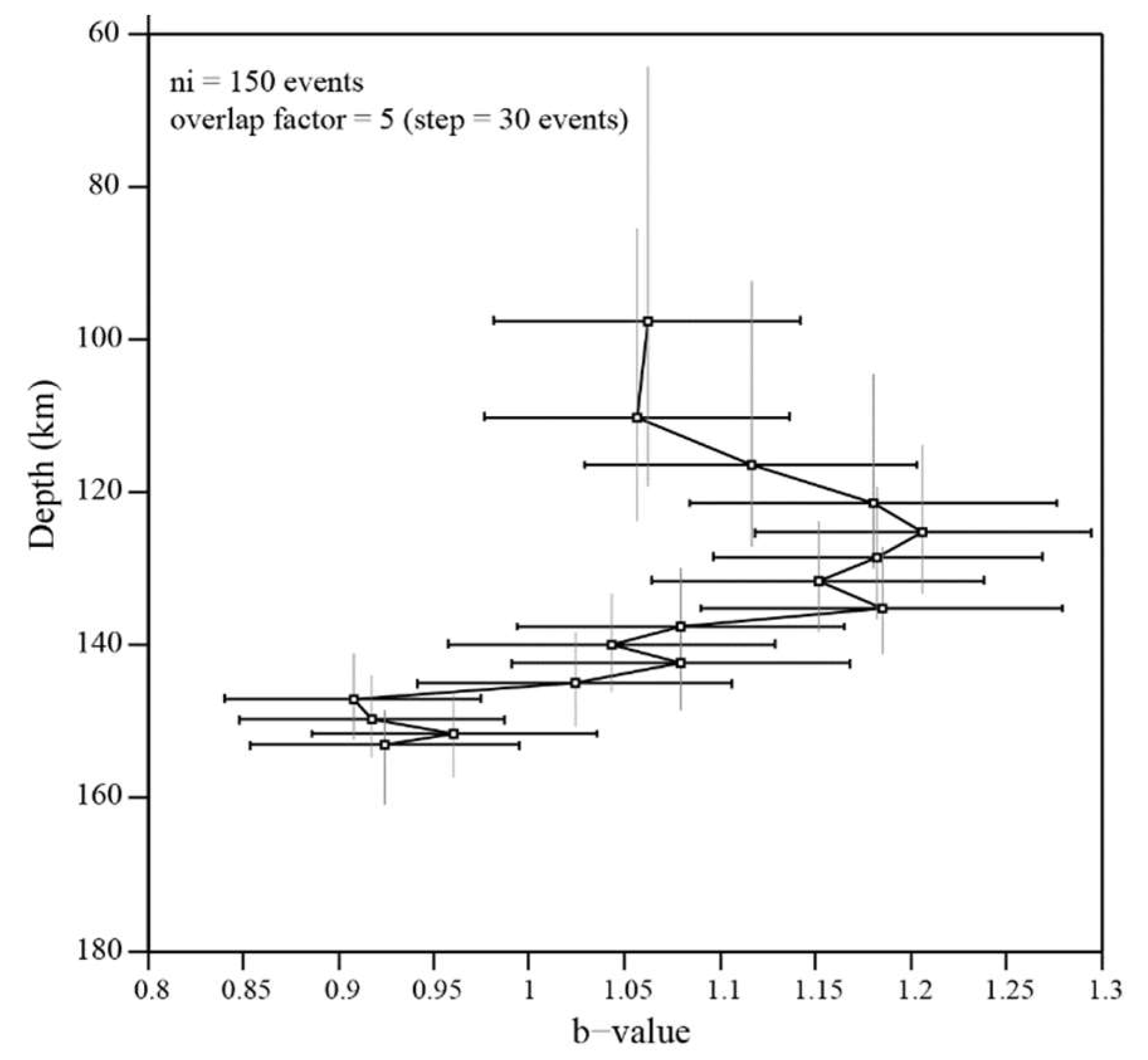

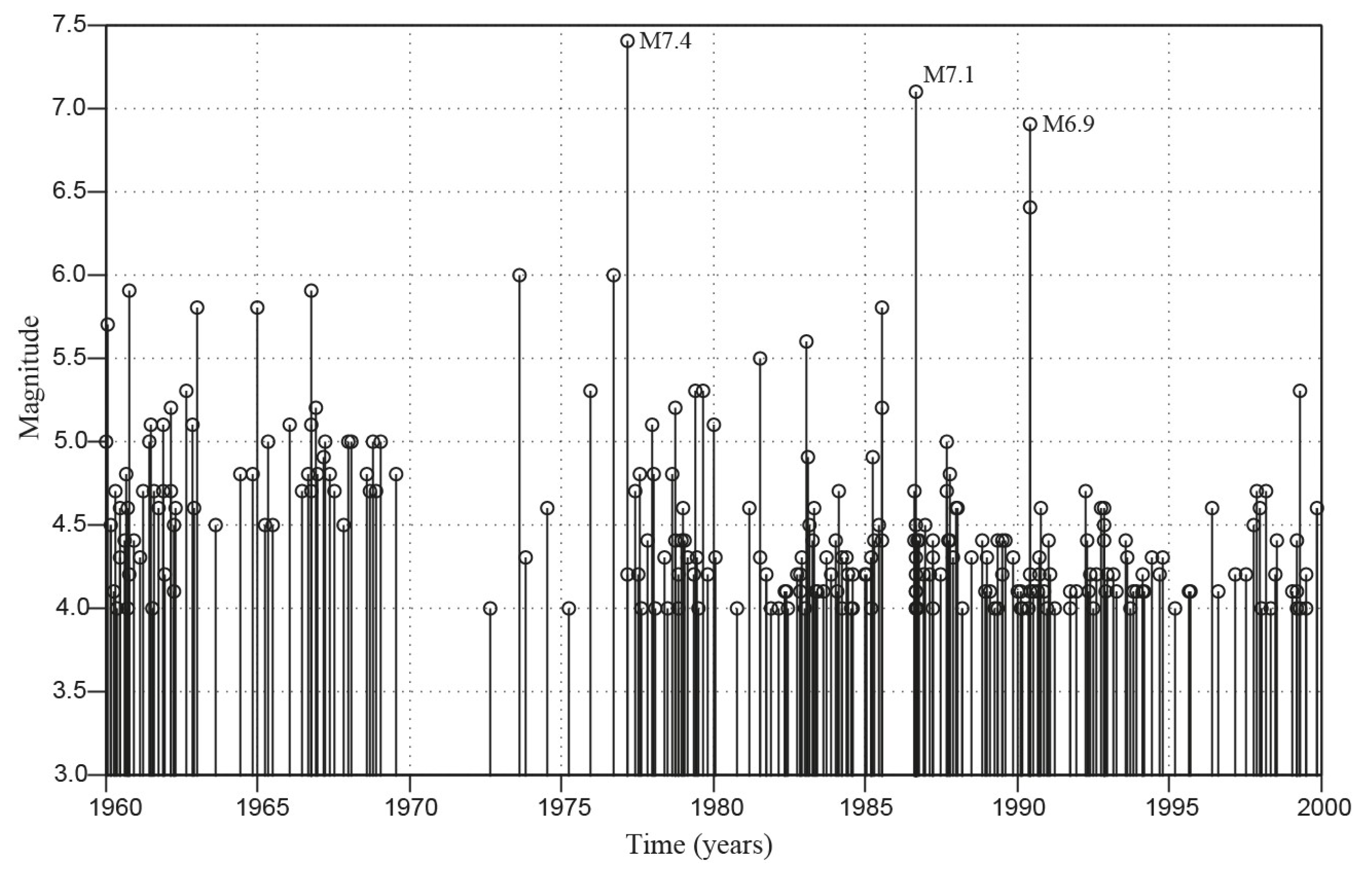
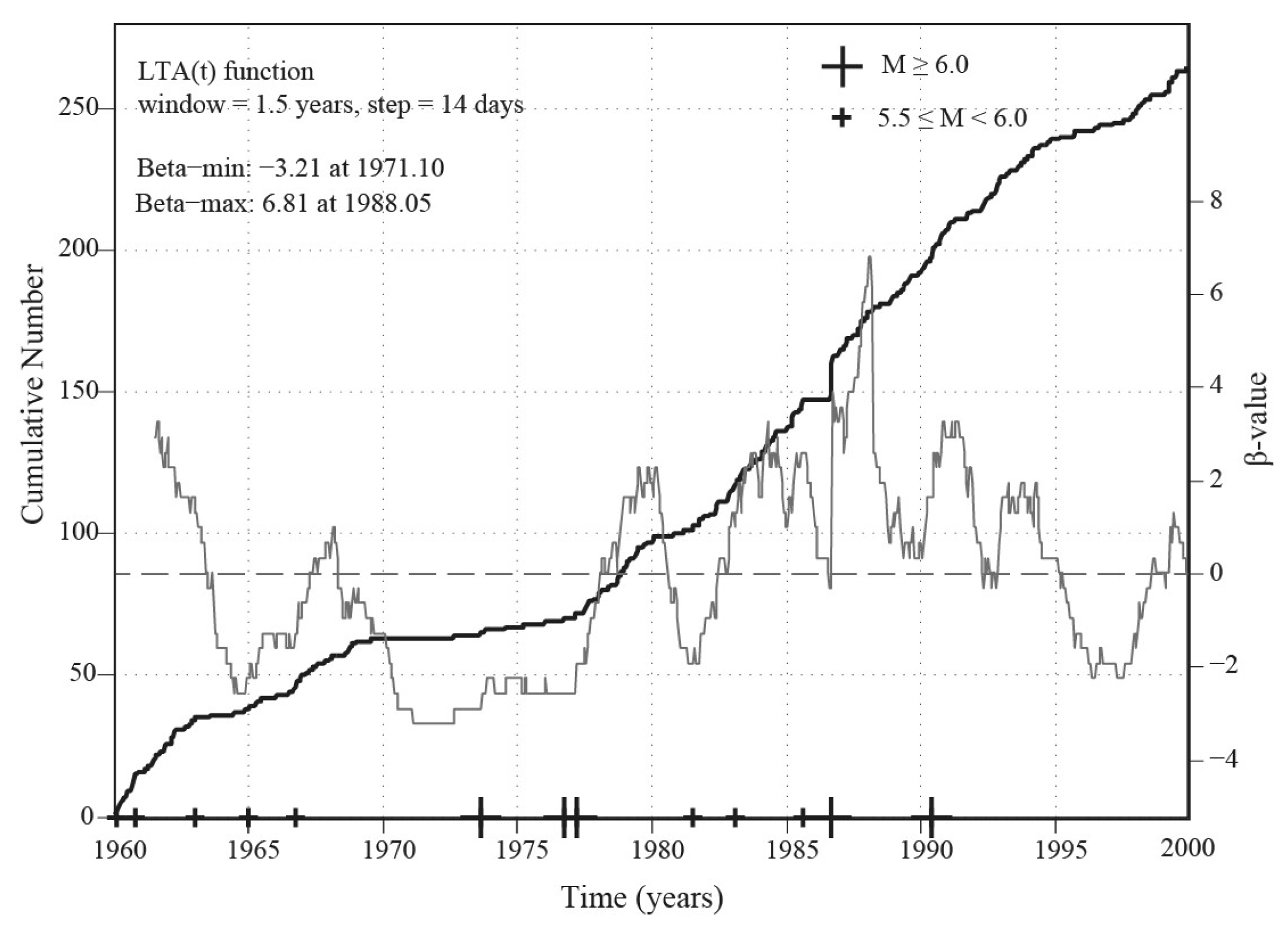
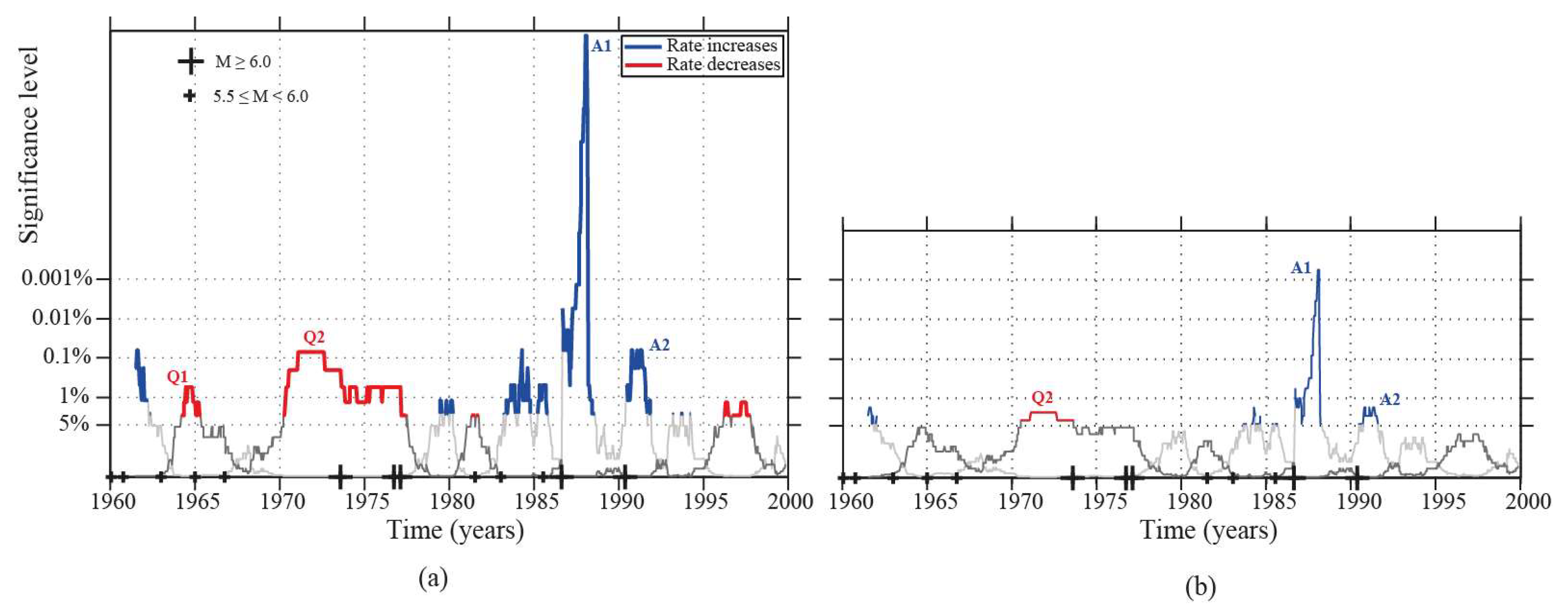
Disclaimer/Publisher’s Note: The statements, opinions and data contained in all publications are solely those of the individual author(s) and contributor(s) and not of MDPI and/or the editor(s). MDPI and/or the editor(s) disclaim responsibility for any injury to people or property resulting from any ideas, methods, instructions or products referred to in the content. |
© 2023 by the authors. Licensee MDPI, Basel, Switzerland. This article is an open access article distributed under the terms and conditions of the Creative Commons Attribution (CC BY) license (https://creativecommons.org/licenses/by/4.0/).
Share and Cite
Enescu, B.; Ghita, C.; Moldovan, I.-A.; Radulian, M. Revisiting Vrancea (Romania) Intermediate-Depth Seismicity: Some Statistical Characteristics and Seismic Quiescence Testing. Geosciences 2023, 13, 219. https://doi.org/10.3390/geosciences13070219
Enescu B, Ghita C, Moldovan I-A, Radulian M. Revisiting Vrancea (Romania) Intermediate-Depth Seismicity: Some Statistical Characteristics and Seismic Quiescence Testing. Geosciences. 2023; 13(7):219. https://doi.org/10.3390/geosciences13070219
Chicago/Turabian StyleEnescu, Bogdan, Cristian Ghita, Iren-Adelina Moldovan, and Mircea Radulian. 2023. "Revisiting Vrancea (Romania) Intermediate-Depth Seismicity: Some Statistical Characteristics and Seismic Quiescence Testing" Geosciences 13, no. 7: 219. https://doi.org/10.3390/geosciences13070219
APA StyleEnescu, B., Ghita, C., Moldovan, I. -A., & Radulian, M. (2023). Revisiting Vrancea (Romania) Intermediate-Depth Seismicity: Some Statistical Characteristics and Seismic Quiescence Testing. Geosciences, 13(7), 219. https://doi.org/10.3390/geosciences13070219






